“Casablanca” - that most romantic of movies - I must have been in my early twenties when I saw it for the first time. I cried then and every time I have seen it since. And then there was Crosby, Stills and Nash singing “The Marrakech Express” about traveling with someone special on the train from Casablanca south to Marrakech. And there were my friends, Rick and Becky, who had been to Morocco. They turned their living room into a Moroccan tent draped in blankets and scarves with cushions on the floor and cooked up a delicious Moroccan feast with couscous and raisins and olives and lamb, new and unusual taste sensations for me at the time. All these experiences stuck with me over the years. How could we not visit Morocco on our round-the-world trip?
So, we put Morocco on our itinerary for nine days, with no idea yet what we would do there. We had some recommendations from a friend of our son about places to see that included the “Blue City” of Chefchaouen in the north, Fes, famous for ceramics and leatherwork, the Atlas Mountains in general, and, of course, Marrakech. I had a vague idea that we would take a train or bus from Casablanca to Chefchaouen and go from there. However, when I started to research the transportation possibilities I realized that we would spend more time in transit than we would visiting the city, and to get from Chefchaouen to Fes or anywhere else would be equally difficult. Eventually, I gave up and contacted the Kimkim Team again, the folks who had been so helpful arranging our visit in Peru. They connected me with Brahim who arranged everything -- a driver to pick us up at the airport and take us on the entire tour as well as specialist guides at each of our destinations to show us the sights and share the history and culture of their country. In addition, he booked us into the most adorable guesthouses, or riads, in the medina of each city. We felt like royalty!
Here is the itinerary:
Day 1: Casablanca Airport to Rabat
Day 2: Rabat to the "Blue City" of Chefchaouen
Day 3: Chefchaouen, Roman Ruins of Volubilis, why not Meknes too if time allows - Fes
Day 4: Fes discovery with your local guide
Day 5: Over the Middle Atlas to Erfoud then Merzouga (Erg Chebbi Dunes)
Day 6: Erg Shibi, Todra Gorge & Dades Valley before arriving at Ouarzazate
Day 7: Ouarzazate, Ait Benhaddou, Tizi-n-Tichka Pass over the High Atlas, Marrakech
Day 8: Marrakech discovery with a Local guide
Day 9: Unfortunately it's time to say goodbye "Casablanca Airport"
Ironic that we didn’t spend any time in Casablanca itself, but it is now a modern metropolis of about four million people with skyscrapers and huge malls. We see enough of those in the United States. However, one thing that might have been fun would have been to visit Rick’s Cafe and Bar, which is designed to replicate the “gin joint” in the 1942 movie. But we ate plenty of delicious food in lots of lovely little cafes during our visit, so we didn’t feel deprived in that regard and we would have felt very underdressed in our traveling clothes -- it looks like a pretty fancy place in the photos.
Day 1: Rabat

Our driver, Mohamed, whisked us off from the airport straight to Rabat, the political capital of Morocco and helped us cart our luggage through the narrow streets of the medina, or old town, to our riad, a lovely little guesthouse with an internal courtyard.

This was the first of many lovely riads and we fell in love with each one. We marveled at the exquisite mosaics and ornate details of the architecture.
For dinner, our host directed us to a cafe a short walk away near the local mosque. While we were waiting for our food, we were serenaded by the call to prayer that suddenly echoed around us.

Here we were introduced to tagine, the traditional and ubiquitous Moroccan stew. I had chicken with lemon and green olives; David had beef and vegetables.
Day 2: Chefchaouen
The next morning, we set off for Chefchaouen. As we sped along in our comfortable modern vehicle with heating and a/c and a wifi hotspot, checking our email, we passed many horse-drawn wagons. This is emblematic of the many ways in which the traditional and the modern co-exist in Morocco.


This part of Morocco, from the coast up through the rolling foothills, is verdant agricultural land, reminiscent of parts of the midwest in the US.
Chefchaouen is located in the drier hills.
It was a treat just to walk the beautiful blue passageways of Chefchaouen and enjoy the brilliant colors in the shops. We took a zillion photos.
There are a variety of explanations of why Chefchaouen is painted many shades of blue including 1) keeping away mosquitos, 2) representing the color of the heavens (or of the sea), and 3) originating with Jewish customs. Whatever the reason, or reasons, it is a very beautiful and special place.
However, what made our visit truly special was our local guide, Abdul. Chefchaouen is his home and exploring it with him gave us a glimpse into the medina as a living community.

He showed us how the medina is made up of a number of neighborhoods, each with its own mosque, a communal well (no longer in use), and a community oven.

We were particularly interested in the ovens since David is a bread baker. Local households send their bread and rolls and biscuits to be baked by the master baker in the wood-fired oven. He seemed proud of his work and was happy to pose for our photos.

Here is the pile of wood out back ready for stoking the oven. It looks like trimmings from the nearby olive orchards.
Abdul frequently greeted people as we passed, including some school children practicing their alphabet from a chart on a wall. They learn Berber, Arabic and English in school and they were eager to practice their English with us. Aren’t they adorable? Just like kids anywhere in the world.

That night we stayed in another delightful riad with beautiful architecture, a romantic bed, and a delicious breakfast.
In the morning it was chilly in the mountains so we had our jackets on when Mohamed took our photo at the entry to the riad.

That day we were off to visit some historic and sacred sites on our way to Fes.
Day 3: Moulay Idriss
Our first stop was the town of Moulay Idriss where Mohamed was excited to arrange a special lunch for us. This time, instead of the ubiquitous Moroccan tagine, the local specialty was bar-b-que -- grilled vegetables and kebabs of various kinds of meat. Quite the feast in the open air of the town square.

When we finished eating, we met our guide for the day, Morit, a citizen of the town and a scholar of local history. He led us up narrow winding paths to the top of one of the two hills on which Moulay Idriss is built.
From here, we could look out over the rooftops toward the second hill and Morit began our history lesson.

Here, Morit is pointing out the green roof tiles of the tomb where the remains of Moulay Idriss el Akhbar, a great grandson of the prophet, Muhammad, lie. Escaping civil war and persecution in Syria, Moulay Idriss arrived in Morocco in 787, bringing Islam to the area and founding the Idrissid Dynasty that ruled Morocco for about two hundred years. Moulay Idriss is considered the most sacred city in Morocco and many muslims make a pilgrimage there each year.
The tomb is closed to non-muslims so the roof was all we saw of it. In fact, the entire town was closed to overnight visitors from outside until very recently, so it has a very different feel than other cities we visited that cater to tourists.
From Moulay Idriss, we drove to the nearby ruins of the ancient city of Volubilis where Morit continued our history lesson. Although the city began as a Berber settlement in about the 3rd century BCE, it later became the capital of the kingdom of Mauritania and then an important city on the outskirts of the Roman Empire, swelling to a population of about 20,000 people in the first and second centuries CE. With Morit’s excellent tutelage we were able to imagine what life might have been like in this bustling town two thousand years ago, with its grand archways, wide paved road, and beautiful mosaic tiled floors. Click on the arrow on the right of the photo to see a slide show of the ruins.

Morit even demonstrated how you would enjoy lounging in the public baths after a hard day.
After saying goodbye to Morit, we set off for Fes. However, on the way we took a brief detour to Meknes, one of the four Imperial cities of Morocco. The others include Rabat, where we began our tour, Fes, where we would be staying that night, and Marrakech, where we would end our tour. Each of these cities has been the capital of Morocco and home to its rulers at one time, or several times, throughout its history.
I would have liked to tour around the city in one of these fancy horse-drawn carriages, but it was late in the afternoon already and we had a long drive to Fes still.


We compromised to save time, and drove around the city walls in the car instead. Even that took a while.
That night, we arrived at another gorgeous riad with the most impressive mosaic work and beautiful carvings.
Day 4: Fes

The next morning, we had a leisurely breakfast on the rooftop of our riad in the morning sun. In the brisk morning air, we welcomed the sun’s warmth -- later in the day, not so much.
Today was entirely devoted to exploring Fes, but we could have spent an entire week there. So much to see -- and taste!
Our guide was Hafid, and the first place he took us was the imperial gates where he gave us our first history lesson of the day. Fes was the first capital of the kingdom. Originally founded by Moulay Idriss in 789, construction and expansion continued under his son, Idriss II. He also pointed out the intricate mosaics that covered the gateway.

Next, Hafid took us to a high point where we could look out over the medina. While we were enjoying the view, Hafid got a message from another tour guide that a woman’s wallet had been found. It turned out that Hafid was the president of the local tour guide association and he quickly put out a message to all its members, found out which tour the woman was with, and her wallet was returned to her before she even knew she had lost it. So, in case you’re wondering if it is safe to travel in Morocco, the tour guides have your back.
Down from the hills, we visited a ceramics workshop where craftsmen create the tiles for the intricate mosaics that adorn the riads and mosques everywhere. First, they glaze flat tiles a variety of colors; then they trace the shapes onto the tile.
And then they painstakingly chip away the excess until they have the shape they want. Unbelievably tedious!
We also watched a variety of other craftsmen creating beautiful vases, plates and pots.
After the tour, we were, of course, given time to peruse the finished products in the showroom, and we bought a tagine pot and some other dishes to have shipped home for us so we could cook up a genuine Moroccan feast for the family.

After that, it was a tour of the food stalls and craft shops of the medina. There was quite a variety including camel heads and modern technology.

We were able to peek into the entryway of the women’s side of the mosque with its elegant arches.
We were also able to explore a restored section of the old Koranic school that housed tiny dormitory rooms on the upper floors.
From the upper window of the dormitory, we were able to see the green tiled roof of the mosque and the oldest continuously operating university in the world.
And no trip to Fes is complete without viewing the famous tannery operations where they process the hides in the same way that they have for centuries.
It wasn’t until after 4:00pm that we finally got a break and a bite to eat at yet another rooftop cafe. This one had a great view of the street below and one of the magnificent city gates.
Day 5: Merzouga
The next morning, it was chilly, so we had breakfast in the lobby where we marveled even more at the intricate mosaics now that we had seen how each little tile was made by hand.
That day was a long and fairly uneventful drive across the Middle Atlas mountains (hills really) and through rocky desert terrain. But, after several days of tours and crowded medinas, it was pleasant to have a break. After all, we had wi-fi so we were able to read and do puzzles on our ipads in air conditioned comfort as we watched the scenery go by.
As we approached Merzouga, our destination for that night, we saw a definite shift in the scenery -- the impressive sand dunes of Erg Chebbi in the distance. Here, we were in for quite the experience!

When we arrived at our guest house, in which we were not actually going to sleep that night, we each packed an overnight bag and they stowed the rest of our luggage for us. Then we were taken to meet our transportation to our sleeping accommodations for the night,

My camel was named Bob Marley and David’s was called Justin Bieber, or at least that is what our camel driver, Mohammed, told us. He also decided that he would call me Fatima and David, Ali Baba, so much easier than trying to remember our English names.
It is quite a feat to stay on the camel as it rises: first the hind quarters go up so you have to lean waaaaaay back, and then its front legs straighten in a very jerky motion so you have to quickly adjust. But, we succeeded, and set off into the dunes to our desert camp.
Partway to the camp, Mohammed insisted on taking our photos for us. In the first one, you can see me hanging on for dear life; if that camel moved, I knew I would fall off and it would be hell getting back on. However, Mohammed coaxed me to let go and strike a triumphant pose, which I managed for about two seconds. The last photo is me telling Mohammed to give me back my phone; that was all the posing I was going to do.
In the background of those photos, you might notice a tan cloud of dust -- that is a sand storm catching up with us. We made it to the tents just in time. The tents were down in a hollow between large dunes so the worst of the storm blew over top of us, but we were still glad to get inside out of it. Apparently, they have to move the camp every few weeks as the dunes move with the winds.

Our “tent” was luxurious. This was the most comfortable bed and the fluffiest of pillows during our entire trip. We even had indoor plumbing with a shower and a flush toilet. Those Moroccans really know how to do “glamping”.
We were told that dinner would be served later in the “restaurant” tent so we stayed inside and rested while the wind howled through the camp for a while. Although there were several other tents in the camp, we were the only guests there for dinner which was, of course, delicious and the restaurant tent was quite adorable.

Day 6: Todra Gorge and Ouarzazate
In the morning, the sky had cleared and we were up in time to climb the dunes and watch the sunrise in the silent desert. A sublime sight.

We also got a better view of the camp in the morning, although it was a bit wind-blown and tattered looking,

Mohammed was there to load us onto the camels and take us back to the guesthouse for breakfast. The ride was about 45 minutes and I was so ready to get off that beast; they are not at all comfortable to ride. There was another group of Chinese tourists on the way back from a different camp as well.

After breakfast, our first Mohamed (they spell the name many different ways) was there to take us to our next stop, Ouarzazate, but there were some sights to see along the way.
We passed an oasis town spread out along a river valley where there were plantations of date palms. We marveled at how the buildings blended into the landscape.
Further up the valley from the oasis, Mohamed pulled off the highway to show us the Todra Gorges -- a series of deep cravasses carved out of glowing cliffs. It was beautiful, but somewhat full of tourists and roadside vendors.
After the Gorge, we passed through a small town where we stopped for a quick lunch and Mohamed took us to a Berber carpet gallery. There was no sign on the outside of the building to advertise it as a store, so, unless you were with a guide you wouldn’t know it was there. Our “host” provided us with mint tea in a room draped with beautiful carpets and explained how the carpets are made by women artisans -- each carpet is a unique artistic creation of fine wool. He and his helpers proceeded to bring out one carpet after another to display them for our admiration, and, hopefully, our purchase, The colors and designs were spectacular and very tempting, but the prices were beyond our budget and we would have had no space in our little house for one of them. But, aren’t they gorgeous….

It was sad to leave those fabulous carpets behind, but, oh well! On to Ouarzazate. Ouarzazate’s claim to fame seemed to be that the Atlas Movie Studio is located just out of town - apparently the largest movie studio in the world. Mohamed offered to take us there for a tour to see old movie sets that are just sitting there deteriorating in the desert sand. Movies such as Gladiator, Kingdom of Heaven, and The Mummy have been filmed there. Also, some scenes from Game of Thrones. However, we have seen none of those so the tour didn’t sound all that appealing to us; we gave it a pass. Movie buffs would probably love it though.
That night, we stayed in a rather modern riad on the edge of town. It even had a small pool.
Day 7: Ait Benhaddou and Tizi-n-Tichka Pass
Today, we were on our way to Marrakech over the High Atlas Mountains through the Tizi-n-Tichka Pass. This pass is an ancient trade route linking Marrakech and coastal Morocco with the Sahara Desert and territories to the south. Ait Benhaddou, a fortified village or ksar, was a major stop on this route, situated in the foothills above the Ounila River that flows down from the mountains.
We stopped at a cafe across the river to have a snack, view it from a distance, and take photos.

Although there is a modern pedestrian bridge across the river, we decided to approach it using a makeshift bridge of sandbags and wood.


On the other side, two camels were patiently waiting for some tourists to go for a ride. Not us!
Today, the ksar is a UNESCO World Heritage Site with only a few families still in residence who act as hosts to tourists. The buildings date from the 17th century and are constructed entirely of local organic materials that need constant maintenance. We were able to explore several buildings and passageways and look at the construction up close.
As you can imagine, this picturesque site has been a popular place for filming desert movies. You can look up the list on Wikipedia.
Mohamed insisted that we should also be filmed on the site.

So we insisted on getting him in the picture as well. By now he was feeling quite comfortable with us, so he hammed it up for the photo.

On our way out, we were invited into the gatehouse to have mint tea with our hosts. Amazingly, they do this with every group of tourists that visit, which must mean many, many times a day during high tourist season.

From the ksar, we went up, up, up and up into a grey, barren mountain landscape. They are still in the process of building a modern highway through this pass so there were spots where we got an inkling of what a difficult, treacherous trip this would have been on camels.

Near the summit, we stopped at an isolated village with a few houses, shops and an amazing cafe. We chose to eat on the roof with a view of the mountains.
The tagine was delicious. Mohamed claimed it was because of the addition of argan oil which is produced right next door. After lunch, we were ushered into the oil factory and given a tour by a charming young woman who let me smell the almond-like nuts that are gathered in the wild, roasted, and ground by hand for their delicious and soothing oil. There was also a little shop where one can purchase cosmetics, lotions and culinary products made with the oil. They were doing a brisk business -- apparently, Moroccan argan oil is highly prized by Europeans and Indians.
From the lofty heights of the Atlas Mountains, we went down, down, down and arrived in Marrakech, our last stop on our Moroccan tour.
Day 8: Marrakech
Another lovely breakfast on a charming riad roof in the chilly morning air.

Our guide for the day was yet another Mohammed. He was not the most engaging person but he made sure we saw as many sights as possible in one day.
We walked through the medina to our first stop, the Saadian Tombs, a necropolis that became the resting place for royalty in the late 1500s. The site consists of gardens and several chambers with grand architecture and ornate decorative tiling and carvings. Everywhere there are graves marked by mosaics, some with raised portions.
I especially liked the sleeping cat.

Tourists are not allowed into the royal mausoleum with the grand caskets. We had to wait in line to get a brief glimpse through an open doorway, so no photos of that.
Interestingly, this necropolis was walled off by a later jealous ruler around 1700 and was neglected and virtually forgotten until a French aerial survey “rediscovered” it from the air in 1917.
Out in the streets again, we came across this street musician who was quite entertaining.
From my later research, I think this is probably Gnawa music, with roots in sub-Saharan Africa.
With our interest in the culinary arts, we were drawn to a spice and tea shop along the way. The friendly storekeeper invited us in to sample and sniff and taste. I wish we had such a store at home.
Our next stop was the Bahia Palace, built during the late 1800s by Si Musa, a descendent of black slaves who was then the Grand Vizier serving the ruler of the time.

The Grand Courtyard is surrounded by various living quarters for his many, many concubines.
Walls, floors, and ceilings are all ornately decorated.
At this point, we left the medina for a short drive to the Majorelle Gardens, built by the French painter in the early 1900s. They cover over two acres and include plants from many parts of the world as well as fountains, pools, and an art deco villa. Apparently, Majorelle thought of his garden as an impressionist painting and labored over it for forty years. After Majorelle’s death, the property was open to the public but became neglected and was almost replaced by a hotel at one point. However, it was purchased in 1980 by Yves Saint-Laurent and Pierre Berge who had fallen in love with it during their visits to Marrakech in the 60’s and 70’s. The building and grounds have been beautifully and lovingly restored. Many of the features in the garden are painted a brilliant cobalt blue reminiscent of Chefchaouen. This specific blue color was developed by Majorelle and is now named after him. However, those areas of the garden were crowded with tourists and it was hot so we retreated to the shaded walkways through the cactus and bamboos forests.
We were getting pretty hungry by this time, so thankfully, we were taken back to the medina and led to an elegant courtyard restaurant where I tried a Moroccan specialty I was curious about - chicken bastilla. Here is how The Spruce Eats website describes it: "A light, crispy warqa pastry shell conceals savory saffron chicken, spicy omelet stuffing, and a crunchy topping of fried almonds sweetened with orange flower water. A garnish of powdered sugar and cinnamon adds to the unique blend of flavors." ,It was certainly unusual!
Fortified with food, we set off on a tour of the souk. Thank goodness we had a guide, even if he was not terribly friendly. The souk is a maze of tiny passages that go every which way. More than once we saw a couple turning a tourist map this way and that, trying to figure out where they were. We marveled at the bright colors and intricate patterns of the displays as we passed shop after shop after shop after shop.
When we got to the silk scarves, the shopkeeper insisted on dressing us up. He gave me a kind of cape and David became Ali Baba for sure.
At the end of this very thorough tour of Marrakech, we returned to the riad to rest.
Day 9: Departure
We had an early morning ride to Casablanca to catch our plane to Egypt. We watched the moon set over the hills as we said goodbye to Morocco and looked forward to our next adventures.






























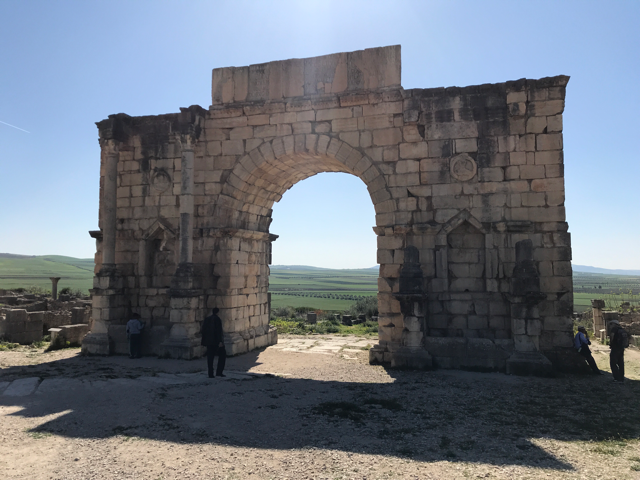

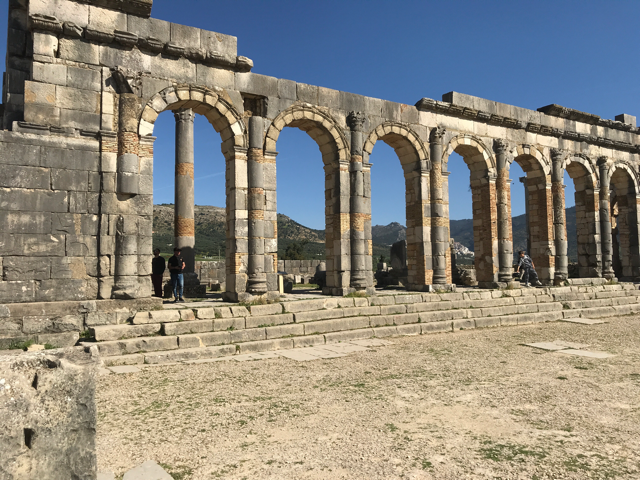

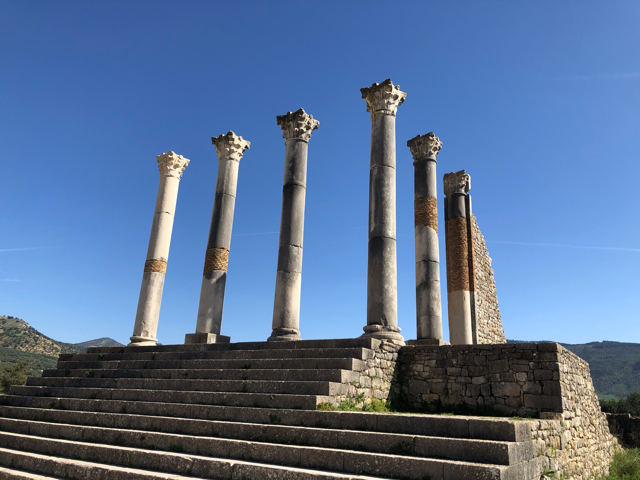

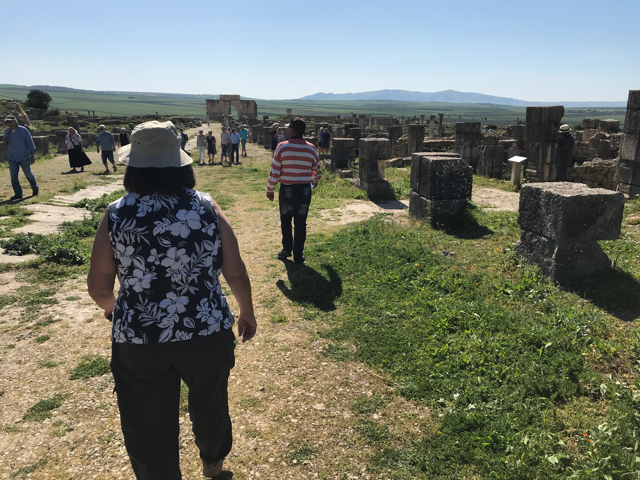







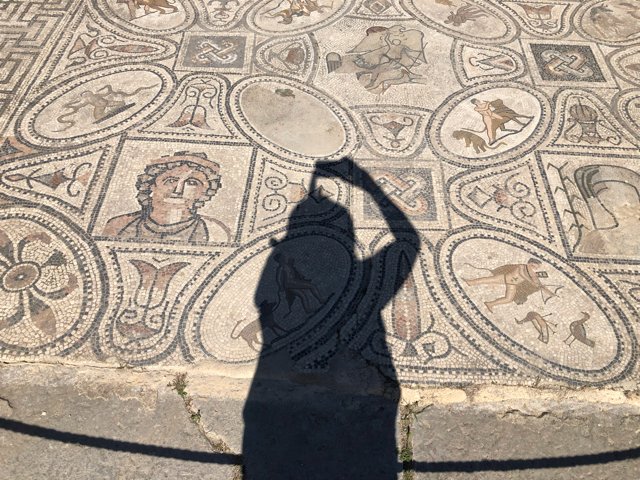

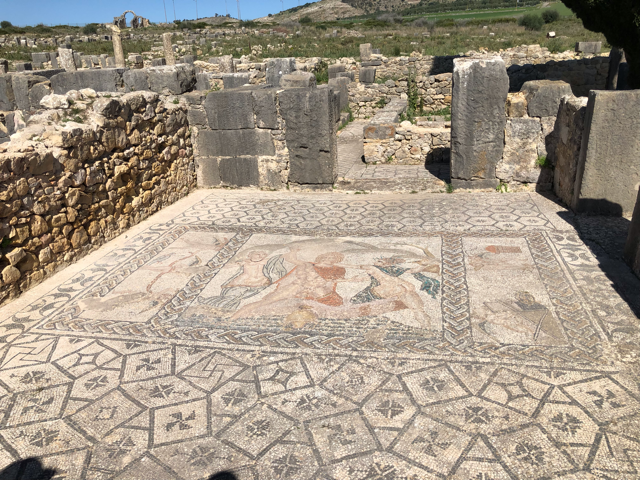








































































































































































Comments